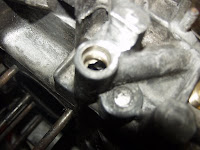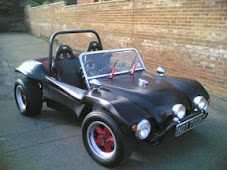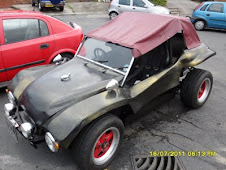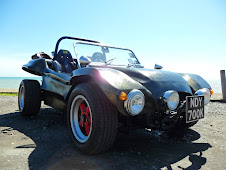 30th June 2009
30th June 2009The idea of rebuilding the bearings of a beetle engine to most people is something best left to the technical amongst us. To be honest this may be true as you get a more accurately built engine , however it is not something that cannot be done in your own garden shed.
Principally the hardest part of rebuilding an engine is changing the main bearings. There are many problems with this as cases are sometimes line bored to accept slightly larger bearings. With this in mind you must be sure which bearing set you need to order. Most good suppliers are only to helpful with this and armed with the correct bearings and your bearing saddles not having any strange grooves or lumps out of them then you can fit the bearings as detailed below. If the bearing saddles are pitted , scored or otherwise trashed you will need a line bore through the bearing sa
 ddles so that the bearings can be seated properly. Generally speaking if you are having a line bore its best to order the bearings through the company doing the line bore to ensure you have the correct ones.
ddles so that the bearings can be seated properly. Generally speaking if you are having a line bore its best to order the bearings through the company doing the line bore to ensure you have the correct ones.The next problem most people encounter is to remove the bearing that sits between the camshaft drive and the number 2 rod shoulder. This is something I have always had done in the shop but to be honest its not as difficult to remove as you would think. To remove the bearing you will need either a three pronged puller or a proper crankshaft bearing puller which unfortunately are fairly expensive. The other thing you will need is plenty of heat , now we are not talking about a paint stripping gun. We are talking about a butane torch that will heat the bearings up to a temperature that they will expand enough to slip of the crank shaft. When you have both of these you can remove the oil slinger by removing the wood ruff key with a screwdriver and hammer to tap it out this will give access to remove the circlip use a screw driver to prise the circlip of the end of the crank. The bearings can then be heated and heated some more until they are hot enough to enable the puller to pull the camshaft gear and distributor gear off. Be careful when they are off as they will still be very hot.
 With the camshaft drive off you can slide the old bearing of the crankshaft. You need to check the bearing surface for any defects. Now putting them back is not the same procedure as taking them off. Ensure that you put the new bearing on with some bearing compound such as Joe Gibbs Assembly lube grease, which will help bed the
With the camshaft drive off you can slide the old bearing of the crankshaft. You need to check the bearing surface for any defects. Now putting them back is not the same procedure as taking them off. Ensure that you put the new bearing on with some bearing compound such as Joe Gibbs Assembly lube grease, which will help bed the bearing in. The next important thing much overlooked is to ensure the camshaft bearing goes back on with the two dots facing towards the end of the crank. The curved in side of the drive needs to go next to the bearing. Now to get the drive back onto the crank you will need to heat up the camshaft drive again. The easiest way of doing this is to pop down to Tesco and buy a cheap saucepan and fill it with engine oil and put both on a camping stove. Watch for bubbles appearing from the drive. When you get this the drive is hot enough to be dropped back onto the crankshaft. Be warned get it the right way round! Also don't go hotter or you will set the oil on fire. Fit the racer spacer next and then use the same process to heat up and fit the distributor drive. Finally the circlip can be replaced. The oil slinger must then be placed back onto the crankshaft it may be necessary to remove the pulley wheels wood ruff key to enable to fit the slinger the concave side must face outwards.The other bearings can then be lubed up and placed on to the crankshaft bearings with the exception of the middle one which must be fitted to the case.
bearing in. The next important thing much overlooked is to ensure the camshaft bearing goes back on with the two dots facing towards the end of the crank. The curved in side of the drive needs to go next to the bearing. Now to get the drive back onto the crank you will need to heat up the camshaft drive again. The easiest way of doing this is to pop down to Tesco and buy a cheap saucepan and fill it with engine oil and put both on a camping stove. Watch for bubbles appearing from the drive. When you get this the drive is hot enough to be dropped back onto the crankshaft. Be warned get it the right way round! Also don't go hotter or you will set the oil on fire. Fit the racer spacer next and then use the same process to heat up and fit the distributor drive. Finally the circlip can be replaced. The oil slinger must then be placed back onto the crankshaft it may be necessary to remove the pulley wheels wood ruff key to enable to fit the slinger the concave side must face outwards.The other bearings can then be lubed up and placed on to the crankshaft bearings with the exception of the middle one which must be fitted to the case.Personally I did not fit my crankshaft at this point but instead checked the play in the con rods which in my case was considerable. The tolerance for measure this is done by inserting a feeler gauge down the side of the con rod. There should be no more than 0.016-inch min by axial measurement. The bearings can be bought for very cheaply and can make a considerable difference if the crankshaft saddles are in good condition. Ensure that you remove and re fit the con rods the same way up. All the notches should face up and the con rod marks should appear the same side for the top as for the bottom. The con rod bolts need to be torqued up to 23lbs. The new bearings made an impressive difference remember to lube them in using the same pre-assembly lube as the crankshaft. With the rod bearings fitted the crankshaft can be fitted on to the bearing saddles. remember to check the dowels are in situe and are in good condition. The bearing need to be aligned so that they fit onto the dowels and the crankshaft will drop into place.
 I decided that I wanted to fit a higher lift camshaft to the engine and had previously chosen an Engle W110 for this engine. I used a Billet Alloy camshaft gear that I had from a previous test comparison. This had been balanced on a lathe as its original casting was poor. The camshaft and drive can be fitted after the cam followers have been lubed and inserted into the case. Ensure that the top of the cam followers have also been lubed. the camshaft bearings are press fitted into the casing on both halves. The larger shouldered bearing fits nearest the drive and the bearing decrease in size towards the flywheel. The camshaft needs to be meshed against the Camshaft . The two dots on the drive gear should nestle neatly either side of the dot that is on the cam gear. This is the correct synchronisation of the two gears and is vital for the timing of the engine.
I decided that I wanted to fit a higher lift camshaft to the engine and had previously chosen an Engle W110 for this engine. I used a Billet Alloy camshaft gear that I had from a previous test comparison. This had been balanced on a lathe as its original casting was poor. The camshaft and drive can be fitted after the cam followers have been lubed and inserted into the case. Ensure that the top of the cam followers have also been lubed. the camshaft bearings are press fitted into the casing on both halves. The larger shouldered bearing fits nearest the drive and the bearing decrease in size towards the flywheel. The camshaft needs to be meshed against the Camshaft . The two dots on the drive gear should nestle neatly either side of the dot that is on the cam gear. This is the correct synchronisation of the two gears and is vital for the timing of the engine. The two half's of the crankcase can be mated to test for binding on the crank. If the crankshaft is free and able to be moved the two half's can be separated and the camshaft seal can be glued with sealant into the case. I used blue hymelar as a case sealant as it stays tacky whilst your assembling. The six central nuts can be tighten remember to diagonally tighten down. Check the crankshaft can still move by placing the front pulley wheel in situe and then place the peripheral nuts and bolts around the case.
The two half's of the crankcase can be mated to test for binding on the crank. If the crankshaft is free and able to be moved the two half's can be separated and the camshaft seal can be glued with sealant into the case. I used blue hymelar as a case sealant as it stays tacky whilst your assembling. The six central nuts can be tighten remember to diagonally tighten down. Check the crankshaft can still move by placing the front pulley wheel in situe and then place the peripheral nuts and bolts around the case.The oil pump can then be fitted into the case a soft rubbermallet can be used to push the oil pump into place. YOu must remove the gears before doing this as they need to be keyed into the camshaft. With the oil pump in place the small block is almost complete rebuild was almost complete. I needed to purchase a full flow oil pump cover as I had decided to go full flow.







.jpg)
.jpg)




























